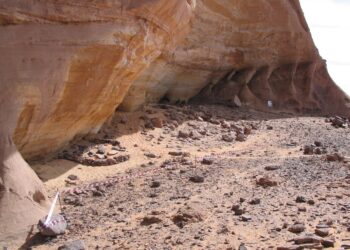In what is now the desert of White Sands, New Mexico, a trail of human footprints crosses the hardened bed of an extinct lake. These lines in the mud are now pushing scientists to rethink the origin story of the Americas.
In 2021, a first analysis of these footprints found that they were between 21,000 and 23,000 years old. This clashed with decades of conventional wisdom. For generations, the Clovis people—named after stone tools found near Clovis, New Mexico—were thought to be the continent’s first settlers, arriving around 13,000 years ago. The White Sands footprints pushed that timeline back nearly 10,000 years, placing humans in North America during the Last Glacial Maximum, the coldest stretch of the last Ice Age.
But controversy quickly followed. Skeptics questioned the materials used for dating, particularly seeds from the aquatic plant Ruppia cirrhosa, which can absorb old carbon from lake water and give misleadingly ancient results. Others said the pollen samples weren’t taken from the same layers as the prints themselves. The footprints remained astonishing—but not yet accepted.
Now, a new study confirms the first line of thinking: that these footprints really are over 20,000 years old.

A Third Line of Evidence
In a new study published in Science Advances, researchers led by University of Arizona geologist Vance Holliday returned to the White Sands site in 2022 and 2023. This time, they focused on a different kind of evidence: ancient mud.
They excavated trenches near the footprint-bearing layers and collected samples of palustrine mud—wetland sediment deposited alongside the ancient lake known as Otero. Radiocarbon analysis of this mud, conducted in two independent laboratories, yielded dates between 20,700 and 22,400 years ago.
That range overlaps cleanly with earlier results from both the Ruppia seeds and conifer pollen. “It’s a remarkably consistent record,” Holliday said. “You get to the point where it’s really hard to explain all this away. As I say in the paper, it would be serendipity in the extreme to have all these dates giving you a consistent picture that’s in error.”
In total, the footprint site now rests on 55 independent radiocarbon dates across three materials—an unusual level of convergence in archaeological dating.
Walking Through a Vanished Landscape
The people who left these tracks walked across what was once a rich wetland. They pressed their footprints into soft alluvium along the lake’s eastern shore, where mud and gypsum sand later buried them. Nearby, prints of mammoths, camels, and giant ground sloths tell of a place alive with Ice Age megafauna.
By looking at the footprints, you get a strikingly good idea of what kind of environment these people were in.
“It’s a strange feeling when you go out there and look at the footprints and see them in person,” said Jason Windingstad, a doctoral student who helped excavate the site. “You realize that it basically contradicts everything that you’ve been taught about the peopling of North America.”
The researchers acknowledge one mystery remains: why haven’t archaeologists found stone tools or other artifacts alongside the footprints? Holliday believes there’s a practical explanation. “These people live by their artifacts, and they were far away from where they can get replacement material,” he said. “They’re not just randomly dropping artifacts. It’s not logical to me that you’re going to see a debris field.”

Should we rewrite the history books?
The implications of the White Sands footprints ripple far beyond New Mexico. If humans were already in southern North America during the Last Glacial Maximum, then they must have arrived even earlier—possibly along the Pacific coast, before glaciers sealed off inland migration routes from Asia.
Apparently, what we thought about the initial human settling of the Americas needs to be reconsidered.
For decades, the Clovis-first model dominated archaeological thought. But findings like the White Sands tracks—and earlier tools found in Florida and Idaho—have steadily chipped away at that consensus. The new study adds critical weight to a shifting view: that humans may have reached the Americas thousands of years earlier than once believed.
Today, most of the landscape where those ancient people walked lies buried beneath shifting dunes. The streambeds have dried up. The megafauna have gone extinct. But the footprints remain, preserving the quiet steps of people who walked here long ago, when ice covered much of the world and humans were just beginning to make their mark on this continent.






